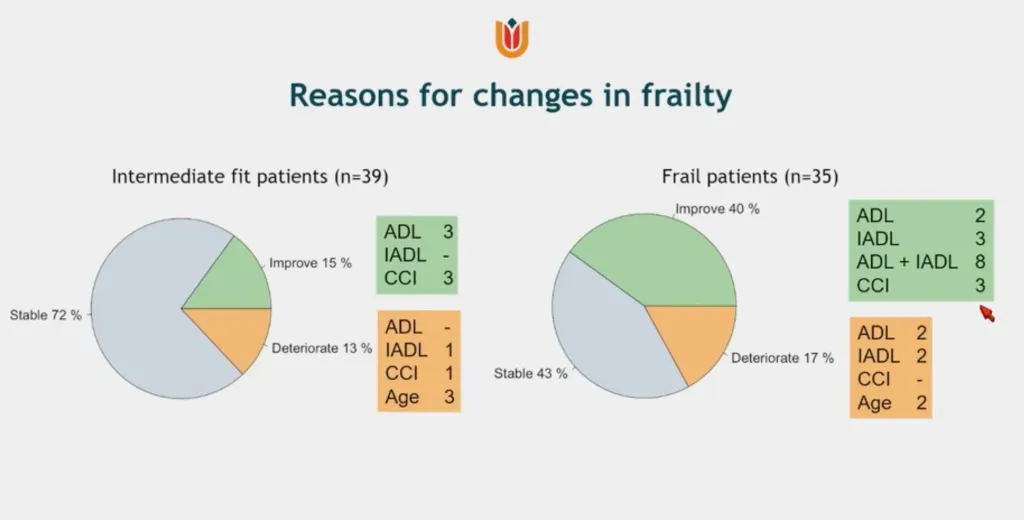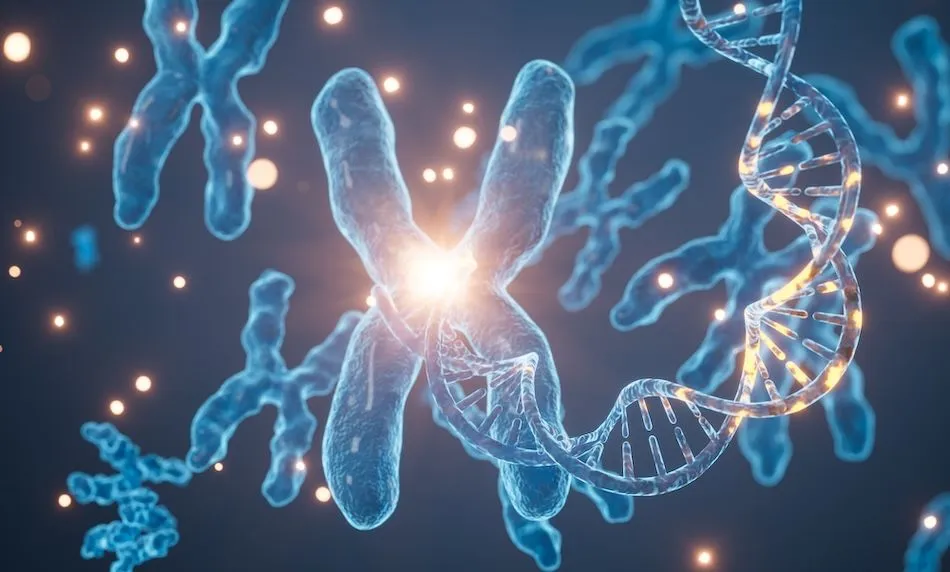ASH 2023: Dynamic Frailty Status Could Provide Better Prediction of Survival Probability

One of the things that makes ASH so exciting is the depth and breadth of international research presented.
Dr. Febe Smits of the Department of Hematology, Amsterdam UMC location, Vrije Universiteit Amsterdam, presented an oral abstract at the 2023 ASH conference that you can learn more about below:
Dynamic Frailty Status Enables Better Prediction of Survival Probability - Results of the HOVON 143 Study
This abstract is important to learn about due to the importance of recognizing newly diagnosed myeloma patient research, especially for those who are older or frail.
Why Look at Fraility?
Frailty has been shown to be prognostic of treatment outcomes in multiple myeloma. It is associated with progression-free survival (PFS), Overall Survival (OS), treatment discontinuation, and non-hematological toxicity.
What Makes this Analysis Noteworthy?
It is known that the clinical outcomes of non-transplant eligible (NTE), newly diagnosed multiple myeloma (NDMM) patients are heterogeneous (meaning that their outcomes vary), and said outcomes largely depend on the patient’s frailty level.
This is the first study to report the dynamics in IMWG frailty assessment of non-transplant eligible patients with NDMM during a clinical trial.
This novel prospective analysis hypothesizes that both myeloma disease burden and treatment burden change over time, and fitness and frailty can also improve or deteriorate.
This study attempts to answer two questions:
- How do frailty scores change over time during treatment?
- Can dynamic (change over time) frailty assessment improve prediction of survival?
Study Designs
While the phase 2 HOVON-143 study was designed to specifically study intermediate-fit and frail patients, the initial focus was to determine the efficacy of Ixazomib/Dara/dex (IDd) in 65 intermediate-fit patients.
Everyone was treated with nine induction cycles of Ixazomib/Dara/dex, followed by maintenance with IDd for a maximum of two years. The results showed that IDd in intermediate-fit patients with NDMM is safe and improves overall quality of life.
This subsequent analysis looks at the frailty dynamics of all 130 patients, 65 scored as intermediate-fit, and 65 scored as frail. Scores were calculated at baseline, after 3, and after 9 cycles.
Looking at Clinical Scoring of Fitness and Frailty
The International Myeloma Working Group-Frailty Index (IMWG-FI) was developed for the prognosis of elderly myeloma patients and for use in treatment decisions and clinical trial design. It is the current gold standard to assess frailty.
There is a scoring system from 0-5 that identifies 3 groups of patients:
- Fit (score =0)
- Intermediate-Fit (score = 1)
- Frail (score ≥2)
The key risk factors for scoring are:
| Risk Factor | Definition | Score |
| Age | ≤75 years | 0 |
| 76-80 years | 1 | |
| ≥81 years | 2 | |
| Charlson Comorbidity Index (CI) | ≤ 1 | 0 |
| ≥2 | 1 | |
| Activities of Daily Living (ADL) | >4 | 0 |
| ≤4 | 1 | |
| Instrumental Activities (use of the telephone, food prep, handling medications and finances, etc.) | >5 | 0 |
| ≤5 | 1 |
If you click on the link below, you can see all the details of this scoring tool:
http://www.myelomafrailtyscorecalculator.net/
Study Results
At baseline- 65 pts were intermediate-fit, 65 pts were frail
- 49% -score 2
- 28% -score 3
- 22% -score 4
- 1% - score 5
At the end of 9 cycles – 82 patients were still on protocol. Frailty over time was known in 74 patients:
- 39 intermediate- fit and 35 frail.
- 6 of 35 patients deemed frail at the outset were re-scored as intermediate-fit at the of 9 cycles
- 1 of 35 patients went from frail to fit
- 5 of 39 patients went from int-fit to frail
This slide provides a great graphic of frailty changes seen at the end of 3 cycles and 9 cycles of treatment:

This next slide captures the answer to HOW frailty scores change. It provides data on how Risk Score Factors were responsible for changes in status:

Of the 35 frail patients:
- 43% were stable
- 40% improved (see slide for breakdown by Risk Factors)
- 17% deteriorated (see slide for breakdown)
Next, let’s look at the answer to the second question, can this dynamic frailty assessment lead to improvement in predicted survival?
As described in the abstract:
- The median duration of follow-up of all 130 patients was 46 months.
- The frailty score improved in nearly half of frail patients and 15% of intermediate-fit patients during treatment for myeloma.
This led to the reclassification of fitness/frailty scores in a substantial number of patients.
Including frailty score as a time-varying covariate in survival analysis by a joint model indicated that the frailty score improved over the course of treatment and that improvement of frailty score was associated with higher survival probabilities (HR 0.58 (95%CI 0.42 – 0.79), p<0.001).
You will see the graphs for one patient in the abstract link below.
https://ash.confex.com/ash/2023/webprogram/Paper180006.html
The authors note that future studies are needed to investigate whether dynamic frailty status is a better predictor for clinical outcome than frailty status at baseline.
What Does this Mean for You as a Patient or Care Partner?
One of the key takeaways is that changes in fitness/frailty status can be used to assess if a patient is being under or over-treated.
You, in turn, can use this information to have a conversation with your myeloma specialist about the dynamic evaluation of your own fitness/frailty status over time, in an effort to optimize your progression-free and survival outcomes.
To learn more about this topic, please watch the video below.
ASH 2023 Resources
Would you like to watch ASH 2023 myeloma research interviews from the investigators themselves? Click "ASH 2023" here: HealthTree University Conference Coverage
To read other ASH 2023 articles, click here: HealthTree 2023 ASH Articles
One of the things that makes ASH so exciting is the depth and breadth of international research presented.
Dr. Febe Smits of the Department of Hematology, Amsterdam UMC location, Vrije Universiteit Amsterdam, presented an oral abstract at the 2023 ASH conference that you can learn more about below:
Dynamic Frailty Status Enables Better Prediction of Survival Probability - Results of the HOVON 143 Study
This abstract is important to learn about due to the importance of recognizing newly diagnosed myeloma patient research, especially for those who are older or frail.
Why Look at Fraility?
Frailty has been shown to be prognostic of treatment outcomes in multiple myeloma. It is associated with progression-free survival (PFS), Overall Survival (OS), treatment discontinuation, and non-hematological toxicity.
What Makes this Analysis Noteworthy?
It is known that the clinical outcomes of non-transplant eligible (NTE), newly diagnosed multiple myeloma (NDMM) patients are heterogeneous (meaning that their outcomes vary), and said outcomes largely depend on the patient’s frailty level.
This is the first study to report the dynamics in IMWG frailty assessment of non-transplant eligible patients with NDMM during a clinical trial.
This novel prospective analysis hypothesizes that both myeloma disease burden and treatment burden change over time, and fitness and frailty can also improve or deteriorate.
This study attempts to answer two questions:
- How do frailty scores change over time during treatment?
- Can dynamic (change over time) frailty assessment improve prediction of survival?
Study Designs
While the phase 2 HOVON-143 study was designed to specifically study intermediate-fit and frail patients, the initial focus was to determine the efficacy of Ixazomib/Dara/dex (IDd) in 65 intermediate-fit patients.
Everyone was treated with nine induction cycles of Ixazomib/Dara/dex, followed by maintenance with IDd for a maximum of two years. The results showed that IDd in intermediate-fit patients with NDMM is safe and improves overall quality of life.
This subsequent analysis looks at the frailty dynamics of all 130 patients, 65 scored as intermediate-fit, and 65 scored as frail. Scores were calculated at baseline, after 3, and after 9 cycles.
Looking at Clinical Scoring of Fitness and Frailty
The International Myeloma Working Group-Frailty Index (IMWG-FI) was developed for the prognosis of elderly myeloma patients and for use in treatment decisions and clinical trial design. It is the current gold standard to assess frailty.
There is a scoring system from 0-5 that identifies 3 groups of patients:
- Fit (score =0)
- Intermediate-Fit (score = 1)
- Frail (score ≥2)
The key risk factors for scoring are:
| Risk Factor | Definition | Score |
| Age | ≤75 years | 0 |
| 76-80 years | 1 | |
| ≥81 years | 2 | |
| Charlson Comorbidity Index (CI) | ≤ 1 | 0 |
| ≥2 | 1 | |
| Activities of Daily Living (ADL) | >4 | 0 |
| ≤4 | 1 | |
| Instrumental Activities (use of the telephone, food prep, handling medications and finances, etc.) | >5 | 0 |
| ≤5 | 1 |
If you click on the link below, you can see all the details of this scoring tool:
http://www.myelomafrailtyscorecalculator.net/
Study Results
At baseline- 65 pts were intermediate-fit, 65 pts were frail
- 49% -score 2
- 28% -score 3
- 22% -score 4
- 1% - score 5
At the end of 9 cycles – 82 patients were still on protocol. Frailty over time was known in 74 patients:
- 39 intermediate- fit and 35 frail.
- 6 of 35 patients deemed frail at the outset were re-scored as intermediate-fit at the of 9 cycles
- 1 of 35 patients went from frail to fit
- 5 of 39 patients went from int-fit to frail
This slide provides a great graphic of frailty changes seen at the end of 3 cycles and 9 cycles of treatment:

This next slide captures the answer to HOW frailty scores change. It provides data on how Risk Score Factors were responsible for changes in status:

Of the 35 frail patients:
- 43% were stable
- 40% improved (see slide for breakdown by Risk Factors)
- 17% deteriorated (see slide for breakdown)
Next, let’s look at the answer to the second question, can this dynamic frailty assessment lead to improvement in predicted survival?
As described in the abstract:
- The median duration of follow-up of all 130 patients was 46 months.
- The frailty score improved in nearly half of frail patients and 15% of intermediate-fit patients during treatment for myeloma.
This led to the reclassification of fitness/frailty scores in a substantial number of patients.
Including frailty score as a time-varying covariate in survival analysis by a joint model indicated that the frailty score improved over the course of treatment and that improvement of frailty score was associated with higher survival probabilities (HR 0.58 (95%CI 0.42 – 0.79), p<0.001).
You will see the graphs for one patient in the abstract link below.
https://ash.confex.com/ash/2023/webprogram/Paper180006.html
The authors note that future studies are needed to investigate whether dynamic frailty status is a better predictor for clinical outcome than frailty status at baseline.
What Does this Mean for You as a Patient or Care Partner?
One of the key takeaways is that changes in fitness/frailty status can be used to assess if a patient is being under or over-treated.
You, in turn, can use this information to have a conversation with your myeloma specialist about the dynamic evaluation of your own fitness/frailty status over time, in an effort to optimize your progression-free and survival outcomes.
To learn more about this topic, please watch the video below.
ASH 2023 Resources
Would you like to watch ASH 2023 myeloma research interviews from the investigators themselves? Click "ASH 2023" here: HealthTree University Conference Coverage
To read other ASH 2023 articles, click here: HealthTree 2023 ASH Articles

about the author
Bonnie Falbo
Bonnie is a Myeloma Coach and the caregiver for her husband with Multiple Myeloma. They live at the foot of the Blue Ridge Mountains in Afton, VA with their 2 dogs and 2 cats.
More on Conferences
Trending Articles




Get the Latest Multiple Myeloma Updates, Delivered to You.
By subscribing to the HealthTree newsletter, you'll receive the latest research, treatment updates, and expert insights to help you navigate your health.
Together we care.
Together we cure.
3x Faster.









